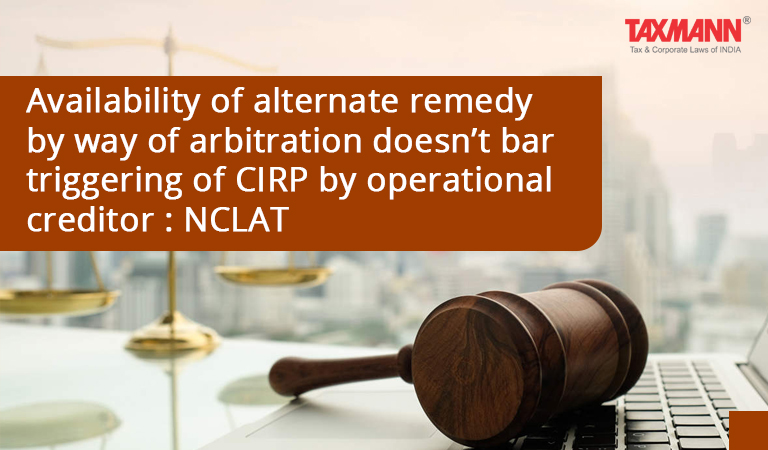Availability of alternate remedy by way of arbitration doesn’t bar triggering of CIRP by operational creditor : NCLAT
- Blog|News|Insolvency and Bankruptcy Code|
- 2 Min Read
- By Taxmann
- |
- Last Updated on 13 December, 2021
Case details: Sodexo India Services Pvt. Ltd. v. Chemizol Additives Pvt. Ltd. - [2021] 128 taxmann.com 271 (NCLAT- New Delhi)
Judiciary and Counsel Details
- Bansi Lal Bhat | Acting Chairperson and Dr. Ashok Kumar Mishra | Technical Member.
- Gaurav Mitra, Y.P. Dandiwala, Ms. Khooshunum R. Daviervala, Ms. Yazdi Jijina and Saswat Pattnaik, Advs. for the Appellant.
Facts of the Case
The operational creditor was an employee of a corporate debtor which due to financial crunch expressed its inability to carry out work from its premises, and, requested the operational creditor to work from home. The Operational creditor accordingly started working from home but had not been paid his rightful salary. Therefore, the operational creditor resigned from the job.
Later, the corporate debtor acknowledged dues that it owed to an operational creditor at the time of his resignation and promised to pay the same at the earliest. Despite several reminders for payment and demand notice, the corporate debtor failed to make payments to the operational creditor. Therefore, an operational creditor filed a Corporate Insolvency Resolution Process (CIRP) petition.
The Adjudicating authority rejected the CIRP application on the ground that the corporate debtor was a solvent company and there being already arbitration clause available in agreement, a dispute could be settled down either through mediation and conciliation or through arbitration. On being aggrieved, the operational creditor knocked at the door of NCLAT.
NCLAT Held
The NCLAT stated that section 238, which has an overriding effect over existing laws or any other law or contract, would not admit alternative remedy being a disabling provision for the operational creditor to seek resolution of a dispute regarding operational debt claimed against the corporate debtor by triggering corporate insolvency resolution process.
The NCLAT held that it was immaterial whether it was solvent or insolvent qua other creditors. Therefore, Adjudicating authority should have, in absence of any dispute contemplated under section 8(2) having been raised by the corporate debtor as a pre-existing dispute and claim of an operational creditor having been satisfied. As a result, an application under IBC was admitted.
Case Review
-
- Harish P v. Chemizol Additives (P.) Ltd . [2021] 128 taxmann.com 270 (NCLT – Beng.) (para 8) reversed
Disclaimer: The content/information published on the website is only for general information of the user and shall not be construed as legal advice. While the Taxmann has exercised reasonable efforts to ensure the veracity of information/content published, Taxmann shall be under no liability in any manner whatsoever for incorrect information, if any.

Taxmann Publications has a dedicated in-house Research & Editorial Team. This team consists of a team of Chartered Accountants, Company Secretaries, and Lawyers. This team works under the guidance and supervision of editor-in-chief Mr Rakesh Bhargava.
The Research and Editorial Team is responsible for developing reliable and accurate content for the readers. The team follows the six-sigma approach to achieve the benchmark of zero error in its publications and research platforms. The team ensures that the following publication guidelines are thoroughly followed while developing the content:
- The statutory material is obtained only from the authorized and reliable sources
- All the latest developments in the judicial and legislative fields are covered
- Prepare the analytical write-ups on current, controversial, and important issues to help the readers to understand the concept and its implications
- Every content published by Taxmann is complete, accurate and lucid
- All evidence-based statements are supported with proper reference to Section, Circular No., Notification No. or citations
- The golden rules of grammar, style and consistency are thoroughly followed
- Font and size that’s easy to read and remain consistent across all imprint and digital publications are applied








 CA | CS | CMA
CA | CS | CMA


